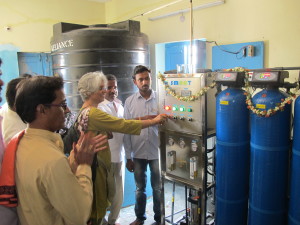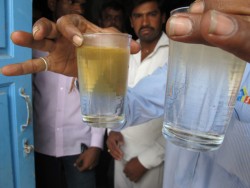 Last month, two members of the Smart Villages team, Dr Shailaja Fennell and Dr Terry van Gevelt, travelled to Hyderabad, India. Arriving in the early morning to the intense heat, the team was met by employees of SMAAT – a social enterprise focused on providing clean drinking water to urban slums and rural villages.
Last month, two members of the Smart Villages team, Dr Shailaja Fennell and Dr Terry van Gevelt, travelled to Hyderabad, India. Arriving in the early morning to the intense heat, the team was met by employees of SMAAT – a social enterprise focused on providing clean drinking water to urban slums and rural villages.
After exchanging greetings, the team set off down dusty roads to Ibrahim Pally village. Situated about two hours outside of Hyderabad, Ibrahim Pally has a population of around 1,000 inhabitants and, like most of the villages in Andhra Pradesh, is served primarily by an unreliable grid connection for up to seven hours a day – although according to villagers, in some weeks it may be seven hours per week!
How does SMAAT work?
Started in 2006 by Karunakara M. Reddy, SMAAT India Pvt. Ltd. designs, manufactures and installs water treatment plants that use reverse osmosis, nano filtration and ultra violet purification techniques. Manufacturing occurs in-house at SMAAT’s humble headquarters in Hyderabad and makes use of easily-sourced and relatively inexpensive off-the-shelf parts.
SMAAT operates under a sustainable business model where they are responsible for addressing technical issues and maintenance, but the community – usually through women self-help groups – are responsible for the day-to-day operation of the water treatment plants. The model is sustainable with SMAAT continuing to expand and water being provided at the affordable price of 5 rupees per 20 litres.
New water treatment plant
At Ibrahim Pally, Dr Shailaja Fennell was given the honour of inaugurating the newly installed SMAAT treatment plant housed in the village centre. The plant uses electricity from the grid to purify water, which is then stored in a large tank allowing for purified water even when there is no electricity. Just outside the village hall is a tiled area with two taps, where villagers are able to access clean drinking water at any time. The first glasses of clean drinking water were appreciated with much fanfare among villagers.
Off-grid clean water?
There is no doubt that social enterprises, such as SMAAT, are making a positive impact in the lives of villagers. Given that it is unlikely for the quality and quantity of grid electricity to improve in rural areas, a future step may involve companies like SMAAT designing similar treatment plants that work on solar or other off-grid technology.
Coupling off-grid energy generation technology with a water treatment plan may help encourage the uptake of off-grid energy in Indian villages and have the added benefit of conserving relatively scarce grid electricity for use in energy-intensive activities such as rural industry.






